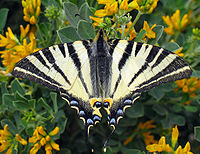
Photo from wikipedia
Papilio hospiton Géné is an oligophagous species, endemic of the islands of Corsica and Sardinia, using various Apiaceae and Rutaceae as host plants, such as Ferula communis, Ferula arrigonii, Peucedanum… Click to show full abstract
Papilio hospiton Géné is an oligophagous species, endemic of the islands of Corsica and Sardinia, using various Apiaceae and Rutaceae as host plants, such as Ferula communis, Ferula arrigonii, Peucedanum paniculatum, Ruta lamarmorae and Pastinaca latifolia. We previously found that the lateral maxillary styloconic sensillum in the larva has two deterrent neurons, one phagostimulant and one salt specific, while the medial sensillum has two phagostimulant neurons, one deterrent and one salt specific. In this work we studied the sensitivity of gustatory receptor neurons (GRNs) to saps of F. communis, F. arrigonii, P. paniculatum, P. latifolia and R. lamarmorae and evaluated the relationship between taste sensitivity to different host-plants and larval growth rate on each of them. The spike activity was recorded from medial and lateral taste sensilla stimulated with plant saps, and GRN response patterns were cross compared in the light of a different feeding acceptance. The phagodeterrent GRNs show a higher activity in response to F. arrigonii and R. lamarmorae than to F. communis, P. paniculatum and P. latifolia. Behavioral trials showed that the time to pupation is significantly longer when larvae are reared on F. arrigonii and R. lamarmorae than on the other host-plants. These results suggest that the different activity of the phagodeterrent GRNs may inhibit food acceptance and extend the duration of the larval stage.
Journal Title: Journal of insect physiology
Year Published: 2017
Link to full text (if available)
Share on Social Media: Sign Up to like & get
recommendations!